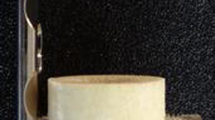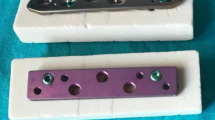Abstract
Purpose
The use of a locking plate eliminates excessive pressure on bone for anatomical reduction and thus preserves the periosteal blood supply, which is important for fracture healing. The far-cortical locking technique with a semi-rigid locking screw reduces structural stiffness and parallel motion, allowing uniform callus formation at the fracture site. Although previous studies demonstrated the superior clinical and biomechanical outcomes of semi-rigid locking screws over rigid ones, it is unclear whether a gap between the plate and bone should be preserved in the far-cortical locking technique.
Methods
The present study conducted finite element analyses with mechanical calibration to clarify the influence of a plate-bone gap on the biomechanical performance of the far-cortical locking technique. A simulated mid-shaft fracture model was fixed using a locking plate and six semi-rigid locking screws. The plate-bone distance was 0 to 2 mm and the axial compressive load was 500 N.
Results
Gliding guidance at the plate-bone interface enhanced parallel intersegmental motion but reduced intersegmental movement, which is a mechanical stimulant for callus formation, and may increase pressure on the bone. Screw stresses increased with increasing plate-bone gap distance.
Conclusion
For the far-cortical locking technique, the results suggest a minor plate-bone gap should be preserved. Engagement between the plate and bone should be avoided both before and after the application of mechanical load.






Similar content being viewed by others
References
Claes, L. (2011). Biomechanical principles and mechanobiologic aspects of flexible and locked plating. Journal of Orthopaedic Trauma, 25(S1), S4–S7.
Frigg, R., Appenzeller, A., Christensen, R., Frenk, A., Gilbert, S., & Schavan, R. (2001). The development of the distal femur Less Invasive Stabilization System (LISS). Injury, 32(S3), SC24–SC31.
Perren, S. M. (2002). Evolution of the internal fixation of long bone fractures. The scientific basis of biological internal fixation: choosing a new balance between stability and biology. The Journal of Bone and Joint Surgery. British, 84, 1093–1110.
Claes, L. E., Heigele, C. A., Neidlinger-Wilke, C., Kaspar, D., Seidl, W., Margevicius, K. J., et al. (1998). Effects of mechanical factors on the fracture healing process. Clinical Orthopaedics and Related Research, 355(Suppl), S132–S147.
Fitzpatrick, D. C., Doornink, J., Madey, S. M., & Bottlang, M. (2009). Relative stability of conventional and locked plating fixation in a model of the osteoporotic femoral diaphysis. Clinical Biomechanics (Bristol, Avon), 24, 203–209.
Stoffel, K., Booth, G., Rohrl, S. M., & Kuster, M. (2007). A comparison of conventional versus locking plates in intraarticular calcaneus fractures: A biomechanical study in human cadavers. Clinical Biomechanics (Bristol, Avon), 22, 100–105.
Button, G., Wolinsky, P., & Hak, D. (2004). Failure of less invasive stabilization system plates in the distal femur: A report of four cases. Journal of Orthopaedic Trauma, 18, 565–570.
Henderson, C. E., Bottlang, M., Marsh, J. L., Fitzpatrick, D. C., & Madey, S. M. (2008). Does locked plating of periprosthetic supracondylar femur fractures promote bone healing by callus formation? Two cases with opposite outcomes. Iowa Orthopaedic Journal, 28, 73–76.
Henderson, C. E., Kuhl, L. L., Fitzpatrick, D. C., & Marsh, J. L. (2011). Locking plates for distal femur fractures: Is there a problem with fracture 272 healing? Journal of Orthopaedic Trauma, 25(Suppl 1), S8–S14.
Lujan, T. J., Henderson, C. E., Madey, S. M., Fitzpatrick, D. C., Marsh, J. L., & Bottlang, M. (2010). Locked plating of distal femur fractures leads to inconsistent and asymmetric callus formation. Journal of Orthopaedic Trauma, 24, 156–162.
Vallier, H. A., Hennessey, T. A., Sontich, J. K., & Patterson, B. M. (2006). Failure of LCP condylar plate fixation in the distal part of the femur. A report of six cases. Journal of Bone and Joint Surgery. American Volume, 88(4), 846–853.
Bottlang, M., Doornink, J., Fitzpatrick, D. C., & Madey, S. M. (2009). Far cortical locking can reduce stiffness of locked plating constructs while retaining construct strength. Journal of Bone and Joint Surgery. American Volume, 91, 1985–1994.
Bottlang, M., Lesser, M., Koerber, J., Doornink, J., von Rechenberg, B., Augat, P., et al. (2010). Far cortical locking can improve healing of fractures stabilized with locking plates. Journal of Bone and Joint Surgery. American Volume, 92, 1652–1660.
Döbele, S., Gardner, M., Schröter, S., Höntzsch, D., Stöckle, U., & Freude, T. (2014). DLS 5.0—The biomechanical effects of dynamic locking screws. PLoS ONE, 9, e91933.
Doornink, J., Fitzpatrick, D. C., Madey, S. M., & Bottlang, M. (2011). Far cortical locking enables flexible fixation with periarticular locking plates. Journal of Orthopaedic Trauma, 25(Suppl 1), S29–S34.
Adams, J. D., Jr., Tanner, S. L., & Jeray, K. J. (2015). Far cortical locking screws in distal femur fractures. Orthopedics, 38(3), e153–e156.
Ahmad, M., Nanda, R., Bajwa, A. S., Candal-Couto, J., Green, S., & Hui, A. C. (2007). Biomechanical testing of the locking compression plate: When does the distance between bone and implant significantly reduce construct stability? Injury, 38, 358–364.
Moazen, M., Mak, J. H., Jones, A. C., Jin, Z., Wilcox, R. K., & Tsiridis, E. (2013). Evaluation of a new approach for modelling the screw-bone interface in a locking plate fixation: A corroboration study. Proceedings of the Institution of Mechanical Engineers. Part H, 227(7), 746–756.
Bottlang, M., & Feist, F. (2011). Biomechanics of far cortical locking. Journal of Orthopaedic Trauma, 25(Suppl 1), S21–S28.
Egol, K. A., Kubiak, E. N., Fulkerson, E., Kummer, F. J., & Koval, K. J. (2004). Biomechanics of locked plates and screws. Journal of Orthopaedic Trauma, 18(8), 488–493.
Ries, Z., Hansen, K., Bottlang, M., Madey, S., Fitzpatrick, D., & Marsh, J. L. (2013). Healing results of periprosthetic distal femur fractures treated with far cortical locking technology: A preliminary retrospective study. Iowa Orthopaedic Journal, 33, 7–11.
Funding
The authors declare that no funds, grants, or other support were received during the preparation of this manuscript.
Author information
Authors and Affiliations
Contributions
All authors contributed to the study conception and design. Material preparation, data collection and analysis were performed by S-PW and C-CL. The first draft of the manuscript was written by C-CL and all authors commented on previous versions of the manuscript. All authors read and approved the final manuscript.
Corresponding author
Ethics declarations
Conflict of interest
The authors have no relevant financial or non-financial interest to disclose.
Ethical Approval
None to declare.
Consent to Participate
None to declare.
Consent to Publish
None to declare.
Rights and permissions
About this article
Cite this article
Wang, SP., Chou, YC., Hsu, CE. et al. Should Plate-Bone Gap be Preserved in Far-Cortical Locking Technique? A Biomechanical Study. J. Med. Biol. Eng. 42, 318–324 (2022). https://doi.org/10.1007/s40846-022-00702-x
Received:
Accepted:
Published:
Issue Date:
DOI: https://doi.org/10.1007/s40846-022-00702-x




